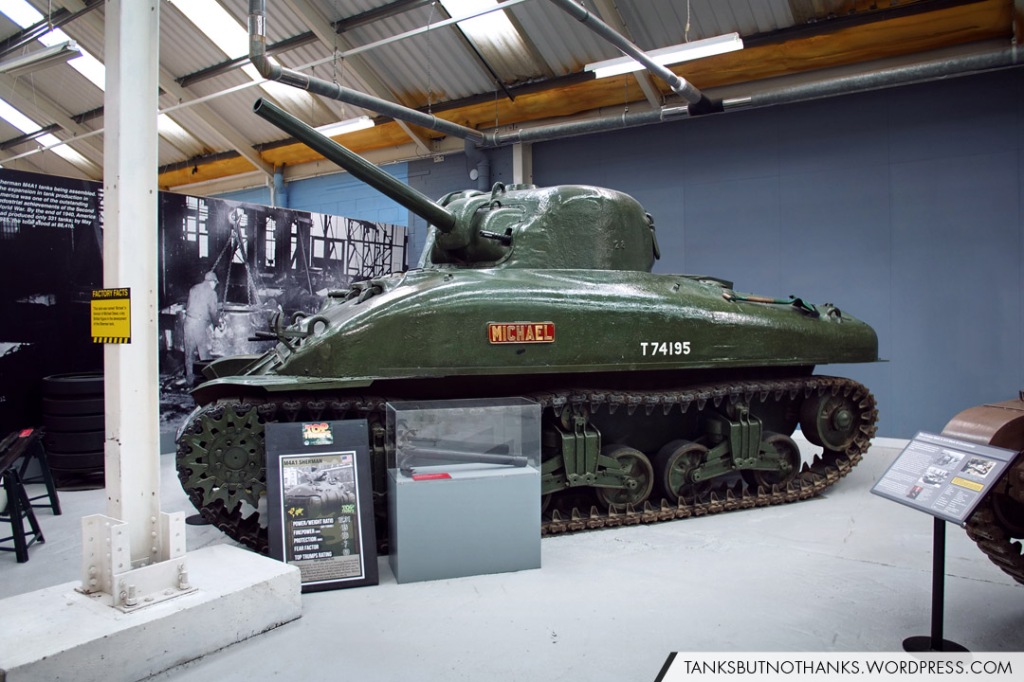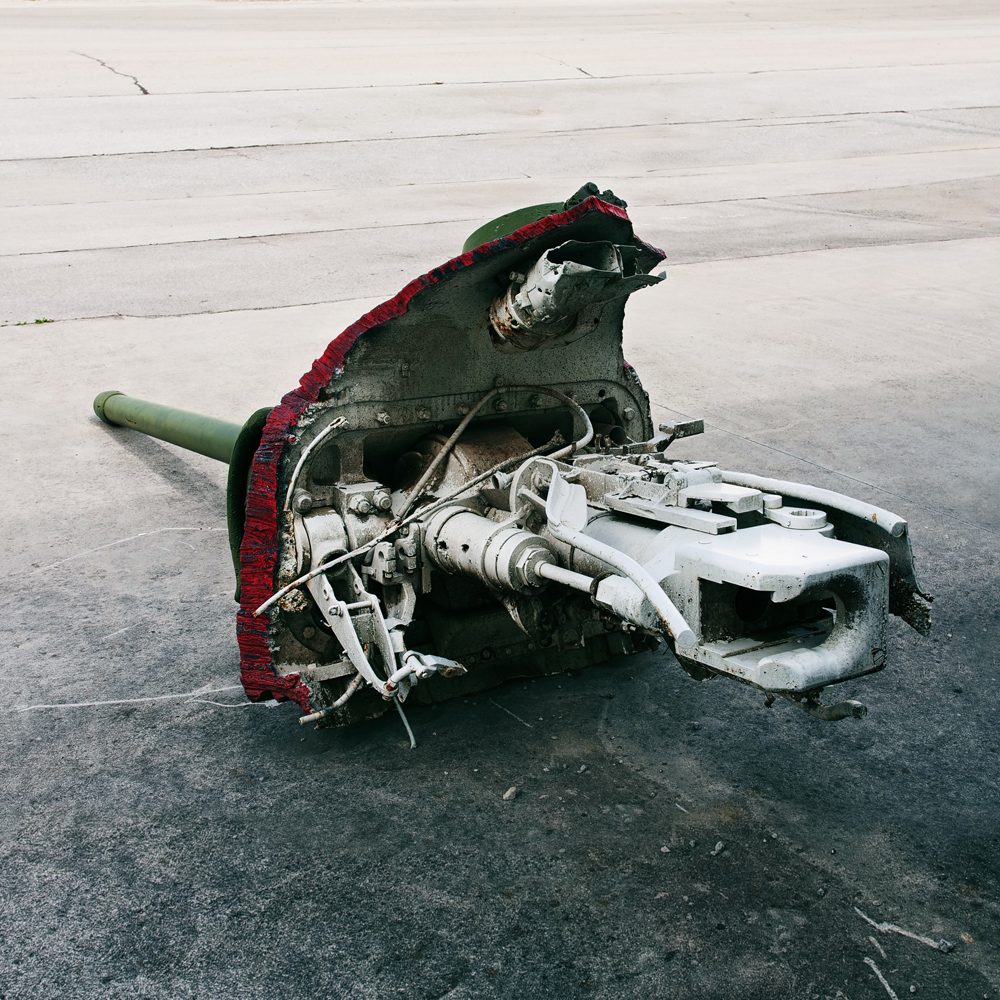Type: Medium Tank
Nation: USA
Period: World War 2
Location: The Tank Museum, Bovington, UK

Combined effort
Like its predecessor, the M3 Lee/Grant, the M4 Sherman was built in a wide variety of versions. This was done to take full advantage of the production capabilities of the vast American automotive industry: No less than eleven factories were involved in building the Western Allies’ World War 2 standard tank. The M4’s seven main versions differed mostly in their engine types and hull shapes. The M4A1 had a distinctively rounded cast upper hull which was cheaper and quicker to produce than the welded hulls. It was the first Sherman variant to be accepted by the US Army, although its designation misleadingly suggests that the standard M4 came first. The designation system for the Sherman’s variants had nothing to do with the order of production. It had simply been adapted from its predecessor Lee/Grant, which had been built as the basic riveted M3, the cast hull M3A1 and four other versions. The M4A1’s lower hull, running gear and the Wright R-975 Whirlwind engine were also all directly inherited from the M3. in February 1942 the first vehicles rolled off the assembly lines at the Lima Locomotive Works in Ohio. Production of the “small hatch” M4A1 ended in December 1943 after 6,281 units.
Turning the tide
When Tobruk fell to the Germans in June 1942, Winston Churchill was with Franklin D. Roosevelt in Washington. Hearing the bitter news, the British Prime Minister asked the US President for as many Shermans as possible. By September 318 units were delivered to the British Army in the Middle East – mostly M4A1s plus a few additional M4A2s. The Sherman first rolled into battle in British service at the Second Battle of El Alamein which began on 23 October 1942. It performed well and soon became the most numerous tank in British armoured formations. Although the Sherman certainly had its flaws, the turret-mounted 75 mm gun put it on par with the latest upgunned Panzer IVs and its mechanical reliability was second to none. The British highly appreciated the Sherman for this quality since they had been struggling to keep their indigenous tanks such as the Crusader and Matilda operational in the rough desert conditions. Because Winston Churchill was allegedly not very good with numbers, the British started to name the US-supplied tanks after American generals. The M4 was named after William T. Sherman, Ulysses S. Grant‘s successor as Commanding General of the Army after the end of the American Civil War. In the US Army the Sherman was simply known as “Medium Tank, M4”. The basic M4 version was called „Sherman I“ in British service, the M4A1 „Sherman II“ and so on and so forth.
The oldest Sherman in the world
This particular vehicle was the second Sherman ever produced and the first of approximately 15,000 Shermans that Great Britain received from the United States. It was built in February 1942 at Lima Locomotive Works in Ohio. While the first pilot tank remained in the United States for testing, the second one was immediately shipped to the UK. After having been displayed at Horse Guards Parade in London it was also used for trials, but it never saw active combat. The Americans chose the name „Michael“ in honour of Michael Dewar, head of the British Tank Mission to Washington. After the British Expeditionary Force (BEF) had been forced to leave most of their armoured vehicles behind at Dunkirk, the Tank Mission was sent overseas in July 1940 to persuade US factories to build British-designed tanks for the British Army. The Americans, however, insisted on only producing vehicles that matched their own requirements and instead offered the brand-new M3 medium tank to their European ally. Half a year later, the Lend-Lease act was signed into law. “Michael” has several early features that were changed before the M4A1 entered full-scale production, for example the two fixed machine guns in the front hull which could be fired by the driver. As they were of no practical use they were omitted from the production vehicles from March 1942 onwards. The drivers’ direct vision slots were also done away with on later models. “Michael” is equipped with the lighter early type suspension bogies with centrally placed return rollers. When the tank arrived in the UK it was carrying a short 75 mm gun M2 with a distinctive counterweight. At some point it was replaced with the longer 75 mm gun M3 which became the Sherman’s standard armament. Since the very first M4A1 pilot (which could be identified by access doors in the sponsons) was not conserved, “Michael” is now the oldest Sherman in the world.


11 responses to “M4A1 Sherman „Michael“”
[…] tank production of the Ram II (based on the American M3 Grant/Lee) and the Grizzly (based on the M4A1 Sherman) had just been declared unnecessary – because the United States’ production capabilities turned […]
LikeLike
[…] Due to a shortage of Continental-Wright aircraft radial engines which were powering the M4 and M4A1, a 375 hp General Motors twin diesel engine was chosen for the M4A2 version, of which eventually […]
LikeLike
[…] which made it much easier to conceal. The M18 was powered by the same radial engine as the M4 and M4A1, but its driveshaft didn‘t run as high up through the fighting compartment. Instead, via a […]
LikeLike
[…] M4 was considered the “standard” Sherman, although the M4A1, M4A2 and M4A3 all went into production earlier. The first of 6,748 early “small hatch” M4s […]
LikeLike
[…] welded hull Sherman that went into production in April 1942 – just two months after the cast hull M4A1. With 8,053 completed units, it was the single most produced Sherman variant. To avoid a production […]
LikeLike
[…] the M4A1 and M4A2, the M4A3 was the third Sherman variant to enter production in June 1942. Rated at 500 hp, […]
LikeLike
[…] shortage of radial engines for the M4 and M4A1 had led to the production of both the M4A2 with an improvised twin diesel engine as well as the […]
LikeLike
[…] Grizzly I cruiser tank was basically a Canadian licence-built M4A1. It is sometimes falsely referred to as the M4A5, but the Americans had actually applied this […]
LikeLike
[…] before the Second Battle of El Alamein, where they would fight against M3 Grants and the brand-new M4 Shermans. It is not clear though if this very vehicle has ever been used in the desert, despite its DAK […]
LikeLike
[…] the amphibious Duplex Drive Tank and the mine-clearing Crab, which were both based on the American Sherman. The heavier British Churchill was converted to fulfill a number of different tasks, including that […]
LikeLike
[…] Forces (IDF) would have to rely on purchasing foreign tank models – mostly the American-made M4 Sherman (later heavily modified as the M50 and M51), the French AMX-13 and eventually the British […]
LikeLike